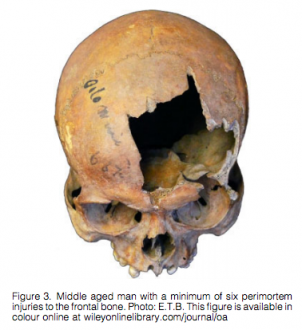Massacre of Family, via Getty Museum
The Medieval period is one characterized throughout the Western world as one of violence. Artwork from this era shows not only violence done towards other cultural groups, but dangers and suffering from daily life. Historical texts document the violence of heroes and villains, their phrases often loaded with drama. Scholars have argued that this violence was part of the social environment and to some extent was institutionalized. However, judgements from text and art alone are limited by individual perception and bias. Human remains have been vital in understanding the extent and manner of violence in the Medieval period. While they too are biased, given that wounds to soft tissue would not be preserved, they provide another source of evidence. Brodholt and Holck (2012) summarize the findings from the Medieval Schreiner Collection of human remains from Oslo in order to create a more nuanced interpretation of the violence occurring in this era.
The Church of St. Mary was erected 1050 AD on the coast near Oslo. The church became an important royal chapel in the 14th century, and its use increased as a place for burial. While the church was open to a range of individuals, the majority of the burials are thought to belong to the upper class. It was the designated burial location for the kings and his descendants. In addition to this, it likely contains the remains of the nobility and the clergy. This site is compared against the Church of St. Clemens, a parish church located northeast of the St. Mary’s. The authors argue that these two sites share similarities in geographical location, dating of the burial church and demographic distribution of weapon injuries. In addition to this they examined a number of mass grave from battle sites across Denmark.

Remains from St. Mary’s were recovered from both the cemetery and inside the church, these were analyzed both separately and together. The collection was highly commingled, however normal analysis took place to determine minimum number of individuals, sex, age, and trauma. They found at least 337 individuals, including 175 males and 71 females. There were 60 subadults, 31 young adults, 101 middle adults, and 109 old adults. Trauma was assessed by comparing wounds against those found at mass battle graves to determine whether they were accidental or due to interpersonal violence. From the cemetery 47% of the male crania and 25% of female crania show signs of violence. From the church 34% of males show trauma on the crania and only 5% of females. The injuries are primarily associated with sword based combat.
In comparison to St. Clemens, St. Mary’s has a predominance of older males. This is likely due to the connection of the church with nobility and clergymen. There is also a higher than normal stature for this church, suggesting that the individuals are healthier, another sign of their connection with nobility. Although there is high trauma, 88% of all crania found, it is not like the trauma found at other sites or battle graves. However, it is similar to St. Clemens. Since the trauma is located primarily on the skull, this suggests that there was a style of fighting the aimed primarily at the head. Comparison with Towton cranial wounds suggests that it wasn’t a frenzied fighting style, but rather was face to face combat of two participants. It is possible that the high number of injuries in the cemetery population is connected with the civil war that occurred during this period. The cemetery burials may have potentially been the king’s men who fought against those who were rebelling.
The historical connection to the civil war during the 12th and 13th centuries is interesting, and definitely has potential given the odd number of head injuries and skewed demography. The authors propose that future research should include weapons analysis and better dating of the assemblage. The sparse documents and information about the role of the church is also something that will be addressed in the future. Personally, I would like to see a closer comparison of injury patterns between different collections, along with comparison of the weapons used. It will be interesting to see how this project develops.
Works Cited
Brødholt, E., & Holck, P. (2012). Skeletal trauma in the burials from the royal church of St. Mary in medieval Oslo International Journal of Osteoarchaeology, 22 (2), 201-218 DOI: 10.1002/oa.1198